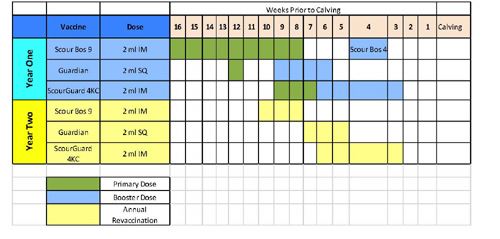Preventing Neonatal Calf Diarrhea Or “Calf Scours”
DR. MICHELE ARNOLD
LEXINGTON, KY.
“Neonatal” calf diarrhea is defined as scours occurring within the first 3 weeks of a calf’s life. Bacteria, viruses and parasites can attack the lining of the calf's intestine and cause diarrhea. The decrease in absorption of essential nutrients from milk leads to weight loss and dehydration. If the disease level is severe, calves often die but even calves that survive will perform poorly for the remainder of their lives when compared to healthy calves. Preventing calf scours involves more than just the immune system of a newborn calf. Excellent cow nutrition during and after gestation, an easy calving process, and environmental management factors all contribute to a successful start. On the flip side, an inadequate quantity and/or quality of colostrum, difficulty calving, poor sanitation, cold, wet weather and overcrowding in calving areas all contribute to a higher risk of disease.
Preventing calf scours begins with a good scours vaccine program in the cow herd. Rotavirus, coronavirus, bacteria (K99 E. coli; Clostridium perfringens Type C, Salmonella spp.) and the parasite Cryptosporidia are the most common causes of neonatal calf diarrhea. Controlling rotavirus, coronavirus and E. coli with vaccines can significantly reduce or eliminate sickness and death losses due to calf scours. Most beef cows produce adequate colostrum but sometimes they do not produce the correct antibodies to fight the specific bugs that cause diarrhea. Scours vaccines are formulated to be given to pregnant cows and heifers late in gestation so they will make the correct antibodies as colostrum is being formed. The 3 most popular vaccines available are ScourBos 9®, ScourGuard 4KC® and Guardian®.
As can be seen from the table above, a first or primary dose followed by a booster dose is required the first year a scours vaccine is used. After the first year, just one annual revaccination is required. Product selection often depends on when you plan to work cattle; generally Scour Bos is administered earlier in pregnancy, followed by Guardian and then ScourGuard which is given late in gestation. If the cow herd has not been vaccinated and calf scours develop, there are oral vaccines available to give newborn calves prior to nursing to provide some immediate protection in the gut.
Newborn calves should receive adequate colostrum within the first 6 hours after birth. Although colostrum can technically be absorbed up to 24 hours of age, the amount absorbed after 12 hours of life is considerably diminished. Once the calf has received colostrum from the dam, it is essential to prevent the environmental load of pathogens or “bugs” from overwhelming the calf’s immune system. Generally, calf scour pathogens build up in the environment as the calving season progresses. Calving in the same area that older calves are in greatly increases the risk to the newborn calf, especially in wet or muddy conditions as we often see in the spring in KY. If possible, close-up cows should be rotated onto clean pastures while cow-calf pairs remain on the old pasture. Additionally, the calving area should be kept as clean and dry as possible. Even the best calving management will have no effect if the first thing a calf ingests is manure from the calving area.
The cows’ diet should provide adequate energy and protein. Calves born to energy deficient cows will have reduced amounts of brown fat which supply energy for the calf to survive initially. Additionally, adequate protein is needed for calf vigor after birth. Weak calves cannot produce sufficient body heat and may be slow to stand and nurse. Remember up to 80 percent of fetal growth occurs in the last 50 days of gestation and cows should calve at a body condition score (BCS) of 5 (heifers at BCS 6).
It is well known calves experiencing dystocia (difficult birth) have a greater risk for subsequent disease, especially calf scours. Trauma associated with a difficult birth severely impacts the ability of that calf to nurse and absorb colostrum. It is important that all dystocia calves are provided with colostrum quickly which usually means using an esophageal feeder rather than waiting for the calf to nurse on his own. In case of a scours outbreak:
• Reduce exposure of newborns to infectious agents:
• Separate healthy pairs from sick calves immediately;
• Be sure equipment, boots and hands are thoroughly cleaned after handling sick animals.
• Move pregnant cows forward to a clean pasture (Sandhills Calving System)
• Maintain clean pens and facilities
• Reduce stress on cows and calves:
• Assist with calving early as necessary, especially with heifers;
• Keep animals as clean and dry as possible (and provide windbreaks in cold weather).
• Good plane of nutrition to the cows and heifers.
• Make sure calves start nursing as soon as possible after calving to get adequate colostrum (10 percent of the body weight in the first 24 hours with at least 2 quarts during the first 6 hours). ∆
DR. MICHELE ARNOLD: DVM (UK Ruminant Veterinarian), University of Kentucky
